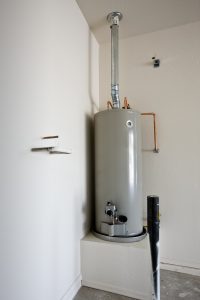 Water heaters are a staple of most modern homes: providing heated water safely and effectively as easily as turning on a tap. They’re located in quiet corners of the house, such as the basement where no one visits especially often, and they usually do their jobs silently and without fuss.
Water heaters are a staple of most modern homes: providing heated water safely and effectively as easily as turning on a tap. They’re located in quiet corners of the house, such as the basement where no one visits especially often, and they usually do their jobs silently and without fuss.
But there’s a downside to such quiet service. When problems arise, they rarely attract notice and can spread until they are extensive indeed. In more than a few cases, what could be a simple repair job becomes an unplanned replacement: driving up the costs and adding time as well as expense to the operation.
The best way to catch problems with your water heater is to schedule periodic maintenance from a trained plumber. There is one maintenance step you can take on your own, and that’s flushing the water tank periodically. It takes just a few minutes, but can prevent a lot of damage before it even starts.
Sediment is a Problem
One of the most common issues with most tank water heaters is the gradual build up of sediment on the bottom of the tank. This is quite common in our part of the world. Texas bedrock leaves a lot of minerals in the water, which are harmless to drink but can be very harsh on the pipes of your home. In the water heater tank, the minerals in hard water can build up in the bottom of the tank, creating sediment.
This is a problem because the sediment forms an insulating barrier between the heat source below the tank and the water it’s intended to warm. Not only will that force the heater to work harder to do its job – raising your bills in the process – but the heat intended for the water will disperse along the bottom of the tank. That adds to the stress and strain on the tank bottom considerably, and can even cause a breach if the issue isn’t dealt with.
How to Flush the Tank
Flushing the tank is an easy process, and can be accomplished with little more than a length of hose and a receptacle to hold the water in (a large bucket, a drain in the floor and so on). The steps are as follows.
- Turn off the gas and electricity to the water heater.
- Open up a hot water tap in a tub or shower in your home and allow it to run for about 10 minutes. (This will reduce the amount of hot water in the tank.)
- Shut off the water to the tank. Leave the shower or tub tap open, which will prevent a vacuum from forming (the water will eventually stop flowing from the tap.
- Open the drain valve in the water heater and attach a garden hose to it. Connect the other end of the hose to a drain or similar receptacle to hold the water.
- Open the pressure valve in the top of the water tank to start the flow of water.
- Wait until the water is drained out of the tank, then turn the water back on.
- Close the pressure valve, close the drain valve, turn off the bathtub or shower tap, and turn on the gas and electricity to the unit.
Call Hutchins Plumbing & Air Conditioning for water heater services throughout Frisco, TX.









